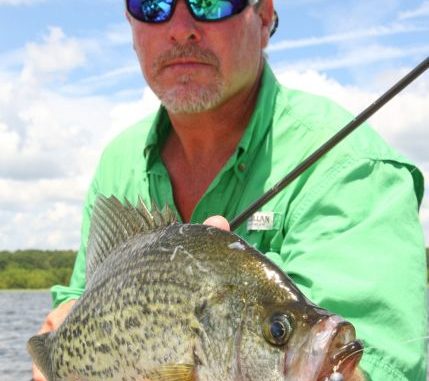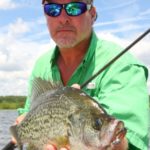
Focus on ‘pinch points’ to target transitioning fish, Thompson says
“They’re en route,” said Jerry Thompson, with Living The Dream Guide Service at Toledo Bend.
And therein lies the problem.
“En route” at Toledo Bend could mean crappie are anywhere from 45 feet at the Chicken Coop to 4 feet in the back of Lanana.
That’s a lot of ground to cover.
“And right now it’s day to day,” Thompson added. “Last weekend, we caught them deep. Yesterday we caught them shallow.”
Typically, the Chicken Coop is the prime winter spot, and the deep crappie bite there lasts until the lake floods or the fish move shallow to spawn.
“Waiting on the water temperature to get right… that’s what they’re doing,” Thompson said. “Some of the little pockets were almost 60 degrees yesterday, so we found some big ones up to 16 inches shallow.”
Thompson explained that crappie are exactly like bass: the first ones to move up to spawn are the biggest.
With so much water to fish, Thompson recommended anglers look for spots that squeeze migrating fish down into a small, condensed area.
“Pinch points, bottle necks… whatever you want to call them, these spots force whatever fish are moving to the backs of the creeks to bunch up,” he said. “In fact, anybody fishing Toledo Bend for the next few weeks should focus on pinch points.”
The move obvious pinch points are bridges. In fact, Thompson considers bridges the number one place to fish crappie this time of year.
Some possible bridges to fish on the Louisiana side are those in Lanana and Negreet. The ones in Negreet are smaller, but Thompson says they do the same thing by choking down an area through with fish have to move.
“I like to fish them at night,” he added. “The SRA (Sabine River Authority) put some lights on Pendleton Bridge and the Lanana bridge, or you can just put out your own lights.”
Thompson likes to fish minnows with a 1/0 or 2/0 split shot half way to the bottom – however deep the bottom may be.
“It sounds strange, but that’s what it is,” he said. “Ninety percent of the fish we catch are half way to the bottom. The only exception is in the dead of winter when they’re on the bottom at the Chicken Coop.”
Believing that there is strength in numbers, Thompson fishes out of a pontoon boat so he can put out as many poles as possible.
“Although the bridges are the most obvious pinch points, don’t discount any bottlenecks going into coves,” he said. “We actually fish some of the creeks like that, and where the creek narrows down, we put out some lights and catch them all because they don’t get fished like that.”
If night fishing isn’t your thing, Thompson said to start shallow in the bays.
“Don’t go to a creek,” he said. “Got to a big bay or cove and head back to where the water temperature is the warmest. Try a jig under a strike indicator, the professional term for cork, or you could go with our number one choice, a Road Runner.”
On the Louisiana side, Thompson pointed out Carrice Creek as being a perennial hot spot once the crappie move up.
“They like to get around what shallow grass is back there,” he said. “But they love getting around those lily pad stems. There used to be a lot of little sticks, and they would hang out on those, but since they’re gone, those lily pad stems are the ticket.”
In Thompson’s estimation, the only way you can go wrong with Toledo Bend crappie fishing is to not go. With so much water and so many places to fish, if you’re not catching crappie in one area, just move.
“There’s always another place to try,” he said.
Editor’s Note: This is the third in a series of articles by Chris Ginn on the current status of the crappie bite across the state. You can view his earlier reports on the Atchafalaya Basin and Lake D’Arbonne by clicking on the links. His next report will be on a hotspot in Northwest Lousiana.




